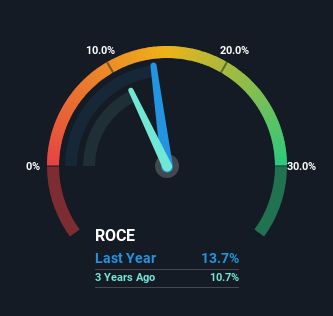- United States
- /
- Food and Staples Retail
- /
- NYSE:KR
We Like These Underlying Return On Capital Trends At Kroger (NYSE:KR)

If you're not sure where to start when looking for the next multi-bagger, there are a few key trends you should keep an eye out for. Amongst other things, we'll want to see two things; firstly, a growing return on capital employed (ROCE) and secondly, an expansion in the company's amount of capital employed. Ultimately, this demonstrates that it's a business that is reinvesting profits at increasing rates of return. Speaking of which, we noticed some great changes in Kroger's (NYSE:KR) returns on capital, so let's have a look.
Return On Capital Employed (ROCE): What Is It?
Just to clarify if you're unsure, ROCE is a metric for evaluating how much pre-tax income (in percentage terms) a company earns on the capital invested in its business. To calculate this metric for Kroger, this is the formula:
Return on Capital Employed = Earnings Before Interest and Tax (EBIT) ÷ (Total Assets - Current Liabilities)
0.14 = US$4.6b ÷ (US$50b - US$17b) (Based on the trailing twelve months to August 2023).
Thus, Kroger has an ROCE of 14%. In absolute terms, that's a satisfactory return, but compared to the Consumer Retailing industry average of 10% it's much better.
View our latest analysis for Kroger

Above you can see how the current ROCE for Kroger compares to its prior returns on capital, but there's only so much you can tell from the past. If you'd like to see what analysts are forecasting going forward, you should check out our free report for Kroger.
So How Is Kroger's ROCE Trending?
Investors would be pleased with what's happening at Kroger. The numbers show that in the last five years, the returns generated on capital employed have grown considerably to 14%. Basically the business is earning more per dollar of capital invested and in addition to that, 43% more capital is being employed now too. This can indicate that there's plenty of opportunities to invest capital internally and at ever higher rates, a combination that's common among multi-baggers.
The Key Takeaway
To sum it up, Kroger has proven it can reinvest in the business and generate higher returns on that capital employed, which is terrific. And investors seem to expect more of this going forward, since the stock has rewarded shareholders with a 73% return over the last five years. Therefore, we think it would be worth your time to check if these trends are going to continue.
On a separate note, we've found 3 warning signs for Kroger you'll probably want to know about.
While Kroger isn't earning the highest return, check out this free list of companies that are earning high returns on equity with solid balance sheets.
Valuation is complex, but we're here to simplify it.
Discover if Kroger might be undervalued or overvalued with our detailed analysis, featuring fair value estimates, potential risks, dividends, insider trades, and its financial condition.
Access Free AnalysisHave feedback on this article? Concerned about the content? Get in touch with us directly. Alternatively, email editorial-team (at) simplywallst.com.
This article by Simply Wall St is general in nature. We provide commentary based on historical data and analyst forecasts only using an unbiased methodology and our articles are not intended to be financial advice. It does not constitute a recommendation to buy or sell any stock, and does not take account of your objectives, or your financial situation. We aim to bring you long-term focused analysis driven by fundamental data. Note that our analysis may not factor in the latest price-sensitive company announcements or qualitative material. Simply Wall St has no position in any stocks mentioned.
About NYSE:KR
Undervalued with solid track record and pays a dividend.
Similar Companies
Market Insights
Community Narratives



